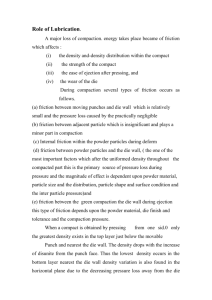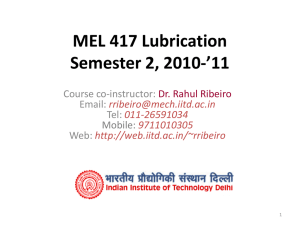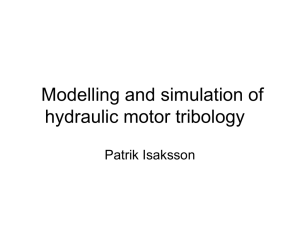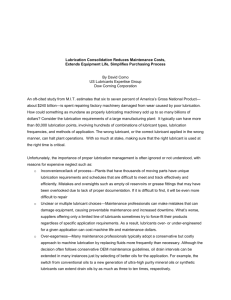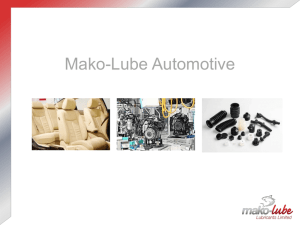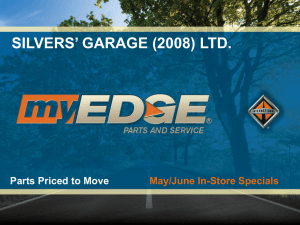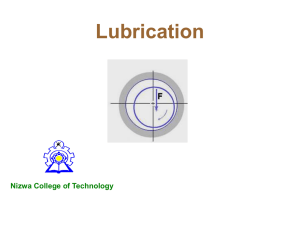What is Dry Lubrication
advertisement
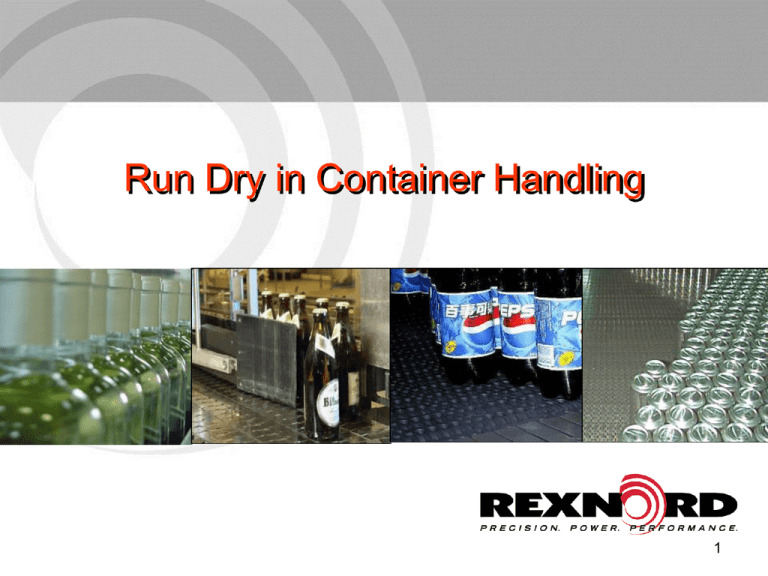
Run Dry in Container Handling 1 Run Dry • Functions of lubrication • • • • • • • • • 2 Reduce friction Even relatively instable containers will slide Extended wear life of chains and components Reduce energy consumption Keep friction etc. at constant level Debris is either repelled or washed down System stayes relatively clean Reduce the noise No static charges are being built up PET- run dry • Customer asks for a dry system • Question: 1. Do conveyors need to be dry? or 2. Can lubrication not be tolerated? 3 1. Conveyors need to be dry • Solution: use plastic chains with dry lubrication • Advantage: • System is ‘dry’, some systems use as little as 10 L lubricant per line per year!! • System is lubricated so friction is reduced with all advantages resulting from that • Note: dry lubrication is not ‘ripe’ yet, supplier must take responsibility and give performance guarantees!! 4 1. Conveyors need to be dry Plastic chains lubricated with silicon based spray 5 2. Lubrication cannot be tolerated • Success depends on many factors: • Container stability • Friction between chain and container • Speed • Lay-out • Other parameters 6 Container Stability • Formula: calculate critical friction coeff.: Fc = R/HS • R=Radius container base • HS=Height center of gravity • Example: stella bottle • Fc=R/H=24/100=0,24 7 Container Stability R/HS > Fw => sliding 8 R/HS < Fw => toppling Stability of Petaloid Bottles R becomes R1 With 5 feet: R1= cos36*R = 0,81*R 9 Friction • Friction is influenced by: • Flatness of chain surface and gaps etc. • Pollution of the surface • Wear • Humidity • Quality of PET Preforms • Temperature • Question: what friction coefficients can be used for calculations? 10 Friction • Friction of PET on plastic chain based on practical experience (tolerance +/- 15%): Friction PET on: 11 DRY Lubricated XLG 0,2 0,15 HP 0,18 0,14 PS 0,16 0,14 PS is still the best material for PET 0.30 0.25 0.20 LF HP™ 0.15 PS™ 0.10 0.05 0.00 Cans Glass Paper PET Friction of PET on several Rex Materials without lubrication 12 Lay-Out • Critical are areas where: • Bottles are accellerated or slowed down • Conveyors are at an angle • Bottles collide unsupported • Chains are being polluted or occasionally get wet • Curves (and the hinge) can heat up; UHMWPE has a low PV-Limit! 13 Other Parameters • • • • • • • 14 Electro-static charges Wear Life of chain Wear resistance of chain Dry-in of cleaning agent How well remain the bottles their shape? With empty bottles: aerodynamics Friction, shape and contact-heigth of guide rails References Real Run Dry • • • • 15 Successful with Rexnord chains Fernbrook spring (water jugs), Milton, Canada Coca Cola Londonderry, USA Robinsons Softdrink, Norwich, UK Other references • Customers who had been promised run dry but found out lubrication was required • Volvic, France • Levissima, Italy • Acqua Vera, Italy • Coca Cola Wakefield, UK • Cott Beverage, UK • Vrumona, Holland • Coca Cola Grigny, France 16 Conclusion • Under perfect conditions the decision to run PET without lube depends on: • Bottle stability and friction on the chain • Rule of thumb: • If bottle stability factor Fc < 0,17: Lubrication is necessary • If bottle stability factor Fc > 0,25: run dry is possible • 0,17 < Fc < 0,25: run dry can only be successful under strict conditions 17 Dry Lubrication 18 Agenda • • • • 19 What is Dry Lubrication Features and Score of All Lubrication Systems Products on the Market Experiences What is Dry Lubrication • An automatic lubrication system with dosing units that put very little lubricant on selected places • Lubricant can be water or oil based, with teflon or solid silicon micro-particles • The most critical part is how the lubricant is distributed on the chain: • Brushes • Shoes • Spray • It can be applied also inside the curves 20 What is Dry Lubrication Dosing unit 21 What is Dry Lubrication Brush distribution system 22 What is Dry Lubrication Wear shoe distribution 23 What is Dry Lubrication Chain surface lubrication 24 Under the chain lubrication Benefits (1) • Dry floors: no water, foam or slime on the floors, which is unsightly & causes accidents due to slipping • No attack on equipment, bearings, motors and floor areas • No slime or soap scum build up, on or under the conveyors • Difficult-to-clean drip trays can be removed. Reduced hygiene schedules, bacteria problems and the smells associated with it • No false through-out from bottle inspector due to foam on bottom • No soapy mess in the labellers or packers resulting in no package damage • No (wet) lube carry-over onto trays and foils, no mould growth and more stable pallets • No ‘bacteriostatic’ lube in waste water system 25 Benefits (2) • Environmental • • • • • Water consumption is reduced Reduction in lube used versus wet lube. Effluent treatment is greatly reduced Total breakdown of lube in the waste water system Reduced power consumption with no increase in forces during bottle build back conditions • Equipments • Reduces the coefficient of friction to the wet lube standards so therefore reduces wear and greatly extends the lifetime of conveyors and wear strips • Motors, drive shaft's, sprockets etc have benefited from large reductions in load and back pressure • Production • With virtually no falling bottles, production will benefit from less stoppages, a better consistency of product and higher yields leading to increased line utilization and efficiencies • Cleaner, safer and more efficient environment 26 Features and Score of Lubrication Systems reduces chain wear inhances product stability reduces energy consumption acts as a cleaner prevents bacteria growth is not sensitive to water hardness does not leave deposits does not need drip trays does not need distribution end dosing system is preventing static electricity build-up prevents powder build-up Run Dry 0 0 0 0 3 4 4 4 4 0 0 Just Water 1 1 1 1 0 0 0 0 1 4 4 19 27 Water&Soap Dry Lubricant 3 4 3 4 3 3 4 2 4 4 2 4 4 3 0 4 0 0 4 3 4 3 13 31 34 Products on the Market • CHP • • • • They claim to be the inventor Good installed base in EU Use wear shoes to distribute lubricant They use XLG chains as reference • Interflon • Lubricant based on Teflon micro-particles • They were the first lubricant supplier of CHP • Use brushes to distribute lubricant • Ecolab DryExx • • • • Lubricant based on Silicone micro-particles They have a contract with CCE in USA Use spray to distribute lubricant They show XLG chains as reference • DryLube • • • • Lubricant not based on Teflon, They sell the full service They are based in UK, main customer base is there They are certificated by CCE (UK) Use brushes to distribute lubricant • Diversey DryTech • Use spray to distribute lubricant 28 Experiences • • • • CHP in CC Antwerpen and SPA gave great results DryExx is giving good results in CCE USA DryLube gave good results in CCE UK Diversey DryTech gave good results in Nestlè Waters and CCE in France • All report excellent results with XLG acetal chains, some reported bad results with NG 29 Water Lubrication Recommendations and Troubleshooting „Hard Water“ 30 What is hard water? • Hard water is a term for water which has high mineral content • Mainly calcium (Ca) and magnesium (Mg) carbonates and other metal ions • All fresh water resources contain these minerals • The quantities of the minerals vary – depending on the geographical region and the geological formation the water went through 31 Problems caused by hard water • Hard water causes scaling • Scale is caused by water evaporating and leaving behind the mineral deposits • These deposits are also known as limescale • Decreases the life of chain, sprockets, wearstrips etc. • Deposit build up around the link and the pin – sandpaper effect 32 Problems caused by hard water Scaling on pin and hinge 33 Levels of hard water • Several different scales with different units • Most common units are: • mg/l CaCO3 Eq. (Calcium carbonate equivalent) • Parts per million weight/volume (ppm w/v or ppm m/v) • °f (french degrees) >> 1 °f = 10 mg/l CaCO3 = 10 ppm • Others: • mmol/l • 1 gr/U.S gal 34 Levels of hard water • Description of hardness correspond roughly with ranges of mineral concentrations: • • • • • • Soft: 0 - 20 mg/L CaCO3 Eq. Moderately soft: 20 - 40 mg/L CaCO3 Eq. Slightly hard: 40 - 60 mg/L CaCO3 Eq. Moderately hard: 60 - 80 mg/L CaCO3 Eq. Hard: 80 - 120 mg/L CaCO3 Eq. Very Hard: >120 mg/L CaCO3 Eq. • Behaviour of the hardness is also affected by • the precise mixture of minerals dissolved in the water • the water's acidity or alkalinity (pH) • temperature • Accelerated wear problems are expected due to hard water when • the CaCO3 present is more than 250ppm (or higher than 20 French degrees) • and the pH is higher than 7. • >> elevated temperatures will also increase the crystal size 35 Prevent scaling on chain and conveyor 1) 36 Water softening • Through so called „ion exchange units“ • Physical-chemical process which filters the water through exchange media (e.g. resin with positevely charged sodium ions) • Relatively cheap, but the unit itself needs occasional maintenance Prevent scaling on chain and conveyor 2) Water treatment 37 • Chemical process • Additives (Chelating agents) mixed up to the lubricant water to prevent mineral deposits • Basically EDTA (Ethylene Diamene Tetracetic Acid) concentration based on hardness condition of the water • Increases lubrication • Consult Lubricant Supplier • Longer chain life due to reduced friction, but can be costly because of constantly need of chemical additive Prevent scaling on chain and conveyor 3) 38 Soap lubricant • Soap lubricant helps to keep the mineral deposits in suspension • Can be very efficient • Depending on the water hardness Running only with water? + + Seems to be a good idea >> no lubricants means less process costs Debris or spilled products are flushed away continously - Very limited reduction of friction - No reduction of bacterial growth - Needs constant monitoring of mineral concentration 39 Running dry? + + Reduced / no lubrication – lower costs No slippery floors, no trouble with tough water pollution regulations • Rexnord has more than 20 years of experience in succesfully dry running applications with LF, HP and PS chains • Specially formulated PS material • Higher PV Limit allows 50% higher speed • Optimized for PET – lowest friction available • Various combinations of factors affect each conveyor’s ability to be run economically without lubrication or with reduced lubrication (see Run Dry section for details) 40 Conclusion • Every plant is different as to the water used in their processes. • Resolutions must be determined by contacting the water softener, lubricant supplier, or a specialized water treatment company. • The final selection is generally based on cost, water quality, and owner or operator preference. 41
